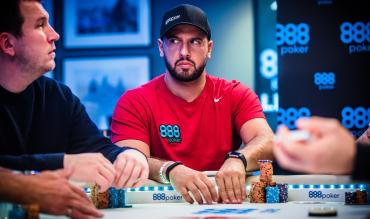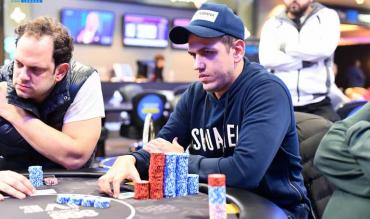It’s no big secret that late position earns the most money in poker. However, we can’t expect the chips to, automatically, flow to us, by virtue of our position.
It’s necessary to understand which advantages are conferred and how best to capitalise on them.
Here we discuss our top SEVEN tips for playing in late position.
Click on any of these poker tips below and jump straight to the poker tip you want.
Tip 1 - Look for Button Steals
The entire game of poker revolves around the blinds. If there were no mandatory blind posts, poker would not exist in the way we know it today.
The button is the absolute best spot at the table to try and pick up the blinds uncontested. Good players raise around 50% (or more) of holdings when it is folded around to them on the button.
We are especially interested when we notice opponents in the blinds who are not defending as frequently as they should. If a button min-raise picks up the blinds more than 57% of the time, it is automatically profitable, even if we always give up when facing resistance. If we spot high folders in the blinds, we can quickly expand our button open-raising range to include any two cards.
Even if our opponents are not folding that much, we don’t want to make the mistake of playing too tight of a range on the button. Even vs non-folding blinds, it is correct to play 40-50% of hands when it’s folded around to us.
Check out this guide for stealing the blinds.
Tip 2 - Look for Re-Steals
Re-stealing is essentially the counter strategy we useif we spot players aggressively stealing as advised in Tip 1. If our opponentis getting out of line when attempting to steal the blinds, he’ll typically be vulnerable to re-steal attempts. A re-steal attempt is essentially a 3bet (re-raise) vs a player who is attempting to steal the blinds.
Of course, without seeing our opponent’s hole cards, we’ll never know if he is attempting to steal the blinds, or whether he holds a legitimate premium. As such, the term “steal” refers to any open-raise made from the CO (cutoff), SB (small blind) or BTN (button).
As a rough guide, if our opponent is folding more than 65% of the time when facing a 3bet, we can profitably 3bet any two cards as a bluff. This strategy is especially true in the BB since no player behind us may wake up with a premium.
Tip 3 - Target Weaker Players
Although we play a wider range of hands from late position, in general, the most obvious incentive to expand even further is when there are weaker players at the table.
For example, we have already discussed open-raising the BTN wider when there are high folders in the blinds. We should also look to open-raise the button wider when there are weaker players in the blinds.
Perhaps these types of opponents are not going to fold overly frequently preflop, but they’ll more than make up for it with the size and frequency of the postflop errors they are likely to make. Put simply, we want to play pots against such players; it accounts for a substantial portion of our overall winrate.
Of course, this is not the only way we can target weaker players in late position. If players at the table are open-limping, we have the opportunity to make iso-raises (especially from the button) in the hopes of initiating a heads-up pot vs a weaker opponent.
We may also look to play a wider range of hands from the SB if we suspect BB is a weak player. Not only can we open-raise wider but we can consider incorporating a SB completing (limping) range in the hopes of playing more heads-up pots against a weak opponent.
Use this guide to help you spot the weaker players at the table.
Tip 4 - Cold Call Wide in the Big Blind
In the past, players have shied away from defending their BB with an overly wide range as a result of being out of position postflop (unless playing vs the SB). In more recent times, good players are now seeing the importance of defending (especially cold-calling) the BB with a wider range.
There are two primary reasons for this:
- When we cold-call in the BB, we are “closing the action”, meaning we are guaranteed to see a flop when calling against an open-raise.
- We effectively get a discount on any BB-defend since we have already invested 1bb into the pot.
On average, a competent player in the big-blind will cold-call roughly 27% of the time when facing an open-raise. (This percentage is an average; they will defend less vs early position opens and more vs late position opens).
Defending BB vs SB opens is especially profitable because, not only do we benefit from the advantages listed above, but we are also guaranteed position postflop. Our BB vs SB defending strategy will be wider than vs any other position.
Check out this guide to the blinds in poker.
Tip 5 - Play Tight in the SB Facing Opens

The SB is perhaps the most problematic of the late positions. Wide ranges are not especially incentivised unless it is specifically folded around to us preflop.
When facing open raises, cold-calling in the SB is nowhere near as profitable as the BB because we still have to worry about a player acting behind us. (We are not “closing the action”). We also don’t get an effective discount as substantialas we get in the BB, (we only have 0.5bb invested rather than 1bb).
We still, of course, look for good re-steal opportunities, especially when playing against BTN opens, but we fold significantly more often than we do in the BB.
The most profitable SB situation is when the action folds around to us preflop, and we can try and steal vs the BB. If our opponent is folding more than about 60% of the time against a SB open-raise, we can typically get away with open-raising any two cards.
We should also look to play a broader range of hands when the BB is a weak player. One part of this involves making use of the SB complete option to initiate heads up pots with the weaker parts of our range.
Tip 6 - Adjust vs Different Sizings
An analysis of hundreds of databases reveals that one of the most common late-position errors is not adjusting correctly vs different open-raise sizings. Many players go so far as to have a rough idea of which range of hands to defend in each preflop scenario, but they don’t tailor this response based on the bet size they are facing.
To give a quick example, think about the following.
We are in the BB and face a 3bb open-raise from the BTN.
What does your defending range look like?
Now imagine we are in precisely the same spot but face a 2bb open-raise from the BTN.
How does your defending range change?
If our answer is that we “mostly defend the same range”, then it’s pretty much a given that we have some leaks in late position. It might seem like a small difference on the surface, but our preflop defending range against a 2bb open-raise should be significantly different against a 3bb open.
This application translates to several other late position preflop scenarios also. For example, we open-raise the BTN to 2bb and face a 7bb 3bet. How does our defending range change if we instead face a 10bb 3bet? It should definitively change, but many players don’t make any adjustment whatsoever.
Tip 7 - Expand from the Cutoff
The CO is very often the overlooked late position. Unfortunately, it doesn’t carry the same winrate potential as the BTN. Any time we open-raise from the CO, we are risking getting action from the BTN, meaning we are going to be out of position, postflop.
Having said that, we don’t want to be completely closed off to exploitative opportunities from the CO.
Here are two example scenarios that it’s worth keeping an eye out for -
- The BTN is playing overly tight. Sometimes the BTN is so tight that we can begin to (almost) treat our CO like a second BTN. For the most part, we have untethered access to the blinds. We need to accept that the BTN is going to wake up with a premium holding occasionally.
- There are weaker players in the blinds. Sometimes the opponents in the blinds are so weak that attempting to play against them is worth the risk of facing action from the BTN. A standard CO raise-first-in (RFI) range usually includes around 27% of holdings. With exceptionally weak players in the blinds, this could expand as far as 40%.
Note, however, that unlike the button, it’s extremely rare that we can push our CO raise-first-in more than 10-15% above its default value. There would typically have to be a very extreme set of circumstances in place for this to be the case. (For example, three extraordinarily tight players behind us.)
Quick Summary of Late Position Tips
Did you get all that?
Here is a quick summary of our recommendations:
- Look for Button Steals - Look for high folders and weaker players in the blinds.
- Look for Re-Steals - Look for aggressive stealers who fold to 3bets.
- Target Weaker Players - Gear strategy around playing more pots against weaker players.
- Cold Call Wide in the Big Blind - Cold call relatively wide in the BB when facing opens, especially vs SB.
- Play Tight in the SB Facing Opens - Cold call relatively tight in the SB when facing opens but look for re-steal opportunities.
- Adjust vs Different Sizings - Defend significantly wider vs smaller sizings.
- Expand from the Cutoff - Look for overly tight opponents on the BTNor weaker players in the blinds.


